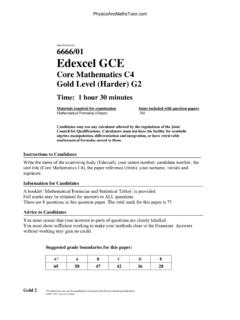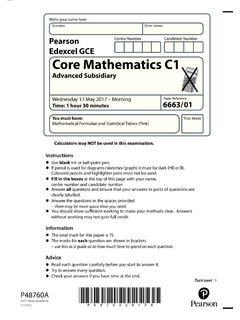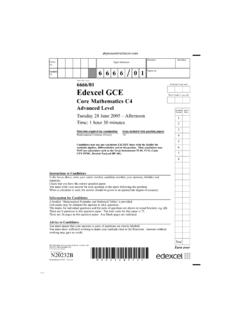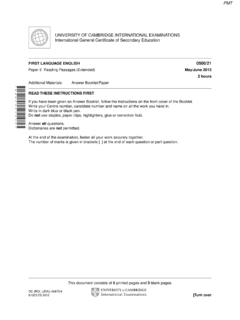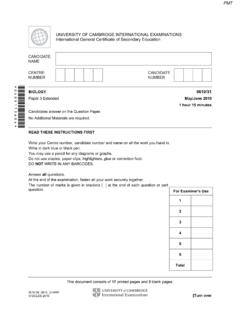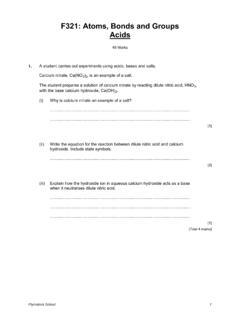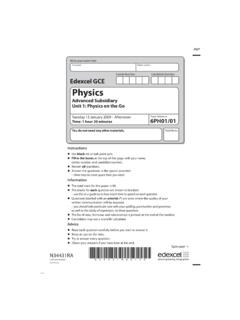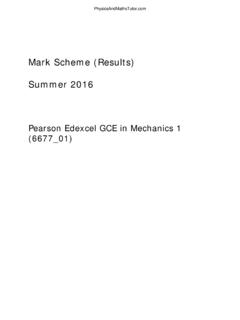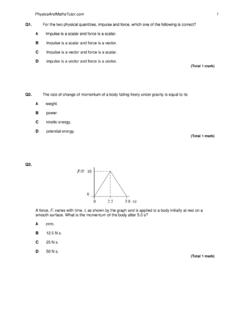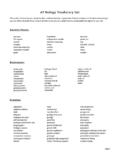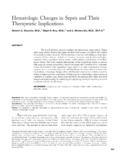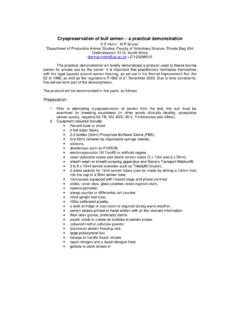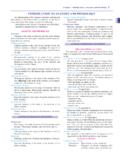Transcription of (a) (i) Name the types of epithelial tissue found in …
1 1 (a) (i) Name the two types of epithelial tissue found in the lungs and airways..[2](ii) The epithelial cells in the lungs are arranged into structures called how the alveoli create a surface for efficient gaseous exchange. In your answer you should use appropriate technical terms, spelled correctly..[5](b) To improve gaseous exchange, the air in the alveoli is refreshed by ventilation. The airmovement created by ventilation can be recorded using suitable apparatus.
2 (i) Name the apparatus used to record these air movements..[1] shows a trace recorded from this ofair in airchamber(dm3) (s)6080100 Fig. (ii) Calculate the rate of breathing over the first minute from the = .. breaths per minute [1](iii) Using the trace, calculate the rate of oxygen consumption over the first your = .. dm3 min 1 [2][Total: 11] Many teachers use models to demonstrate and explain breathing and lung function in mammals. Fig. is a model of the mammalian tuberubber bungballoonsflexible rubber sheetsecured to the sidesof the bell jarglass bell jarFig.
3 (a) When the rubber sheet is pulled down the balloons why the balloons expand..[3] (b) A teacher used the model in Fig. to demonstrate the difference between tidal volume andvital capacity.(i)Explain the meaning of the term tidal volume..[2](ii)Suggest how the teacher may have used the model to demonstrate tidal volume..[2](iii)Explain the meaning of the term vital capacity..[2](iv)Suggest how the teacher may have used the model to demonstrate vital capacity..[1][Total: 10] In an experiment to measure the rate of diffusion, a student placed cubes of agar jelly containing an indicator into dilute hydrochloric acid.
4 The indicator changes from pink to colourless in acidic student used cubes of different sizes and recorded the time taken for the pink colour of each cube to disappear student s results are recorded in Table of side of cube(mm)Surface area of cube(mm2)Volume of cube(mm3)Surface area to volume ratioTime taken for pink colour to disappear (s)Rate of diffusion(mm s 1) 2 24 :1 5 150 :1 600 1 000 4008 :1 40027 :11 (a) (i) Calculate the surface area to volume ratio of the cube with 10 mm sides.
5 Show your = .. [2](ii) Using the data in Table , describe the relationship between the rate of diffusion andthe surface area to volume ratio.. [2] (iii)Explain the significance of the relationship between rate of diffusion and the surface areato volume ratio for large plants.. [2](b) Another student used the same raw data obtained in the experiment but calculated a differentrate of diffusion for each cube. This student s results are shown in Table of side of cube(mm)Time taken for pink colour to disappear (s)Rate of diffusion(mm s 1) 2 5 this student s table, the calculation of the rate of diffusion is incorrect.
6 (i)Suggest the method used to calculate the rate of diffusion in Table .. [1](ii)State why the method in (b)(i) is not correct.. [1] (c) In mammals, the lungs are adapted to enable efficient gaseous table below lists some of the adaptations of the the table explaining how each adaptation improves efficiency of gaseous this adaptation improves efficiency of gaseous exchangesquamous number of blood [4][Total: 12] (a) List three reasons why a large, multicellular animal, such as a mammal, needs a transport system.
7 [3]Fig. , on the insert, shows the nervous pathways that coordinate heart action. Above the diagram is a trace showing the electrical activity associated with one heart beat.(b) (i) State the full name given to a trace showing the electrical activity of the heart..[1](ii)Identify the components of the heart labelled A and B on Fig..B ..[2](c) (i) During the electrical stimulation of the heart, there is a short delay between the excitationof the atria and excitation of the ventricles.
8 Explain why this delay is essential..[2] (ii)The Purkyne tissue carries the excitation wave down the septum to the apex of the why the excitation wave is carried to the apex..[2][Total: 10] Fig. shows the changes in the volume of air in the lungs of a student at rest during one (s)volume ofair (dm3)456 ABXCFig. (a) (i) Name the measurement represented by the line X..[1](ii)What is happening to the elastic fibres in the walls of the alveoli at point A? ..[1] [Total: 10] (b) Explain what causes the change in the volume of air between points B and C on Fig.
9 In your answer you should use appropriate technical terms, spelt correctly..[4](c) Using Fig. , calculate the breathing rate of this student in breaths per = .. breaths per minute [2](d) About 1 dm3 of air cannot be expelled from the lungs. This is known as the residual why it is not possible to expel all the air from the lungs..[2]
